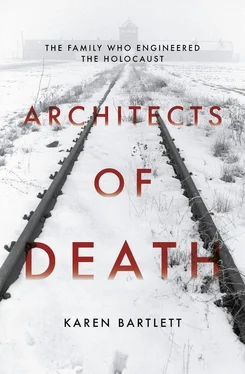It is work that the company appears to be proud of: instead of recoiling from the immediately apparent nature of these horrors, company director Ernst Wolfgang Topf writes to the SS at Auschwitz on 4 November 1941 to explain that the new design will ‘improve efficiency’, even taking into account the higher fuel consumption of ‘frozen’ corpses. ‘Rest assured,’ Ernst Wolfgang writes, ‘we shall supply an appropriate and well-functioning system, and we commend ourselves to you with a Heil Hitler.’ So proud are they of their work that Kurt Prüfer takes the opportunity a month later, on 6 December, to write to Ernst Wolfgang and Ludwig Topf demanding more money for his design: ‘It was I who worked out how to create the three- and eight-muffle cremation ovens, mostly in my free time,’ he boasts, ‘These ovens are truly ground-breaking, and may I assume that you will grant me a bonus for the work I have done.’ [4] Kurt Prüfer personnel file, Landesarchiv Thüringen - Hauptstaatsarchiv Weimar.
This staggeringly inhumane debate seems a far cry from the origins of J. A. Topf and Sons, founded in Erfurt sixty years earlier, in 1878, by master brewer Johann Andreas Topf. Yet the company was marked from the beginning with some of the same characteristics of technical innovation, unsteady business fortunes, and a strain of mental instability in its founders.
Johann Andreas (J. A.) Topf was born in Erfurt in 1816, the eldest son of farmer Johann Sebastian Topf and his wife Maria Magdalena, who was part of the town’s Schlegel brewing family.
Alongside glassblowing, brewing was one of Germany’s few growth industries at the time. Nevertheless, to live in Erfurt, or in fact almost anywhere in Germany, was to live in a small world. Erfurt was a ‘working town’ that had become wealthy in the fourteenth and fifteenth centuries due to the trade in woad, a yellow-flowered plant used in blue dye. In comparison to its close rivals, Erfurt had neither the cultural and literary delights of Weimar, which still gloried in its golden age of being home to Goethe and Schiller, nor the university tradition of Jena. The term ‘working town’ was relative, however, and a visitor would have encountered small handicraft businesses, crooked streets and livelihoods controlled by strict guilds all conducting local commerce. Germany itself (still a loose assortment of states just beginning to map out some of the bureaucratic processes it would become known for) was considered by fellow Europeans to be a slumbering, ‘quaint, half-timbered land’ of poets and dreamers, and ‘a country whose industrial goods were still regarded, even in the 1870s, as cheap and nasty’. [5] David Blackbourn, History of Germany 1780–1918, Blackwell Publishing, 1997, p. 1.
J. A. Topf lived with his parents and five siblings at 34–35 Krämpferstrasse, where the family continued to run their farm. When he was fourteen he left school and undertook military service. He then began training as a brewer with his uncle, Johann Caspar Schlegel and, after serving his apprenticeship, J. A. Topf struck out on his own – moving to Stolberg in Saxony to set up his own brewery. By the age of thirty-six he was ready to marry, and chose the daughter of a local master baker, who was nine years his junior, Johanne Caroline Auguste Reidemeister. Together they moved back to the Topf family home in Erfurt and had five sons, four of whom lived to adulthood. Gustav was born in 1853, Albert in 1857, Max Julius Ernst in 1859 and Wilhelm Louis, known as Ludwig, in 1863.
Back in Erfurt J. A. Topf began brewing beer on the family farm, but he proved to be a poor businessman. Topf’s first attempt to establish a brewery on the property met with disaster when his business partner turned out to be a crook, according to Topf’s son Julius, and the family lost both their property and all of their funds, including Johanne Topf’s dowry. Remembering the ‘great hardship in the house’, [6] Annegret Schüle, Industrie und Holocaust: Topf & Söhne – Die Ofenbauer von Auschwitz, Wallstein Verlag, 2010, pp. 29–30. AS footnote 69: Mein Lebenslauf [ My Life ] (E.W. Topf), undated (presumably early 1946). ThHStAW [PK: i.e. Thuringian State Archive, Weimar], Collection: Jean-Claude Pressac Nr. 81, sheets 1–22, this quote from sheet 1. Dieter Wettig, grandson of the Topf director, Heinrich Wettig (died 1926), was one of Ernst Wolfgang Topf’s playmates. He confirmed that the family lived on company land (statement made by Dieter Wettig to the author). The baptismal register shows the address as Dreysestraße 7. Baptismal register of the Merchants’ Church, Erfurt, 1903/4.
Julius Topf said the family’s poverty had made a lasting impression on the four sons, especially by comparison to some of their rich relations. The situation was so dire that even the baker refused to give the Topfs credit to buy bread.
After the loss of their home, the family moved to another address while J. A. Topf tried his hand at cultivating vegetable seeds and earning money as a self-employed firing technician. Although his business skills were always limited, Topf had discovered that his real talent lay in invention and innovation. In 1867, he began advertising his boiler and oven optimisation services and two years later persuaded the well-known Erfurt food manufacturer, Casar Teichmann, that they could produce a high-quality beer together using Topf’s brewing methods. The beer, which was called Nestor, was indeed so successful that Teichmann acquired the old Topf family property in Krämpferstrasse and established his own brewery there, with J. A. Topf in place as master brewer. Once again, however, the partnership foundered when Teichmann asked Topf to work for half his previous salary due to his increasing age. Julius Topf would later claim that Teichmann had not appreciated his father’s ‘mightily forward-striving spirit’, and the two parted company – with Topf choosing to try again to capitalise on his own technical expertise.
At the age of sixty-two it was a bold move, and one his children did not agree with. Despite their opposition, by July 1878 J. A. Topf had moved the family again, to 10b Johannesflur, and restarted the business using his patent for the firing system used in the brewing process. In the brewing process malt was ground and then cooked in the brew pan along with water and hops. The Topf-controlled firing system was innovative and more efficient, as it led to less burning on the base of the brew pans and used less coal. Future generations of the family would consider 1878 the official founding of Topf and Sons, but despite winning a few contracts in the Thuringia region, the company was still struggling.
In 1884 J. A. Topf’s second youngest son, Julius, joined the business. Julius, who would become Hartmut Topf’s grandfather, had given up training for the civil service and also a prospective career as a fruit farmer and gardener to become a furnace technician. A year later, his youngest brother, Ludwig, joined him in the firm and in 1885 they refounded J. A. Topf and Sons as specialists in heating systems and brewery and malting installations, employing a draughtsman and moving the business out of the family home and into rented office space.
Julius felt he had relieved his parents of a burden by taking over the business, particularly as his father was now mentally unstable. Julius said the ‘hard times’ and worries his father had endured had sapped his spirit, later writing to his wife that while his father was no longer ‘au fait’ enough to work, when left to his own thoughts he ‘quickly turns almost crazy’ and that he suffered from an ‘enormous vanity’ bordering on megalomania.
When he died in 1891, J. A. Topf left behind little in the way of business success, but he had founded a company and his technological innovations would outlive him. During his troubled lifetime, Germany had undergone the most profound transformation. Moving from a country which had, at the time of his birth, resembled a Grimms brothers’ fairy tale (a place of dark woods, wolves and bereavement, where people were often poor and hungry and suffered random cruelties) to become a fully-fledged nation. Although it was a unification led throughout the 1860s by the Prussian statesman Otto von Bismarck, it was driven in part by the underlying forces of social and economic dynamism emerging from a new, confident and wealthy class of businessmen, bankers and manufacturers. Men who were similar to, but more successful than, J. A. Topf.
Читать дальше












